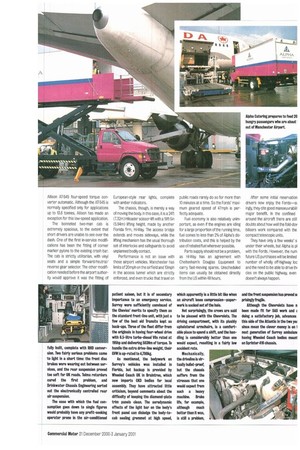Surrey Ambulance Service
Page 16

Page 17

If you've noticed an error in this article please click here to report it so we can fix it.
M The leafy lanes of Surrey conceal a large, spread-out population-1.1 million residents, plus a considerably higher number of transients, thanks largely to the M25 and the neighbouring airports of Heathrow and Gatwick. The nature of
the county poses particular problems to an emergency ambulance service, which is judged by its paymasters on its response times. Surrey Ambulance Service has made great efforts to ensure its front-line units are located as close to the action as possible, largely by the use of out-stations spread strategically through the county. Nineteen locations deal with up to 300 calls a day, and up to 37 vehicles are on duty at peak times.
Transport is chosen for its suitability for particular tasks. Honda PanEuropean motorcycles arid Vauxhall Vectra cars provide first response, while a paramedic on foot has been found to be the best way to provide rapid Intervention at Gatwick (which is In Sussex, but is covered by Surrey Arnbulance Service). The flexible policy has helped greatly with meeting response targets; but another factor to be considered is the performance of the mainstream van-based ambulances.
Two years ago the SAS emergency fleet consisted of Ford Transits with 2.9-litre Cologne V6 petrol engines and automatic transmission. But as the fleet got older and less reliable, replacements were needed, and Ford no longer offered the V6. A careful analysis of the European market found nothing was available at that time which met the stringent requirements for performance and safety But help was at hand, in the form of the service's then director of engineering, who had experience of American vehicles. After initial Investigations found them to be suitable, the first eight vehicles were acquired early in 1999.
The ambulances are based on the Chevrolet 3500 chassis-cab, with Type 1 bodywork by Wheeled Coach Industries of Florida. The power is from a 5.7-litre V8 petrol engine producing 255hp and 447Nm, driving through automatic transmission to the rear wheels. The 4,200kg GV1V vehicles were imported
fully built, complete with RHO conversion. Two fairly serious problems came -to light In a short time: the front disc brakes were wearing out between services, and the rear suspension proved too soft for UK roads. Telma retarders cured the first problem, and Drinkwater Chassis Engineering sorted out the electronically controlled rear air suspension.
The ease with which the fuel consumption goes down to single figures would probably have any profit-seeking operator prone in the air-conditioned
patient saloon, but it is of secondary importance to an emergency service. Surrey were sufficiently convinced of the Chevies' merits to specify them as the standard front-line unit, with just a few of the best old Transits kept as back-ups. Three of the fleet differ from the originals in having four-wheel drive with 6.5-litre turbo-diesel V8s rated at 195hp and delivering 583Nm of torque. To handle the extra drive-line weight, their CVW is up-rated to 4,700kg.
As mentioned, the bodywork on Surrey's vehicles was installed in Florida. but backup is provided by Wheeled Coach UK in Braintree, which now imports CKD bodies for local assembly. They have attracted little criticism, beyond comments about the difficulty of keening the diamond-plate trim panels clean. The aerodynamic effects of the light bar on the body's front panel can dislodge the body-tocab sealing grommet at high speed,
which apparently is a little bit like when an aircraft loses compression—paperwork is sucked out of the hole.
Not surprisingly, the crews are said to be pleased with the Chevrolets. The
driving compartment, with its plushly
upholstered armchairs, is a comfortable place to spend a shift, and the han dling is considerably better than one would expect, resulting in a fairly low accident rate.
Mechanically, the drivellne is virtually bullet-proof, but the chassis suffers from the stresses that one would expect from such a heavy machine. Brake life, for example, although much better than it was, is still a problem,
and the front suspension has proved a prisingly fragile.
Although the Chevrolets have n been made fit for SAS work and E doing a satisfactory job, advances this side of the Atlantic in the two yoi since mean the clever money is on next generation of Surrey ambulani having Wheeled Coach bodies mounl on Sprinter 416 chassis.








































































































































